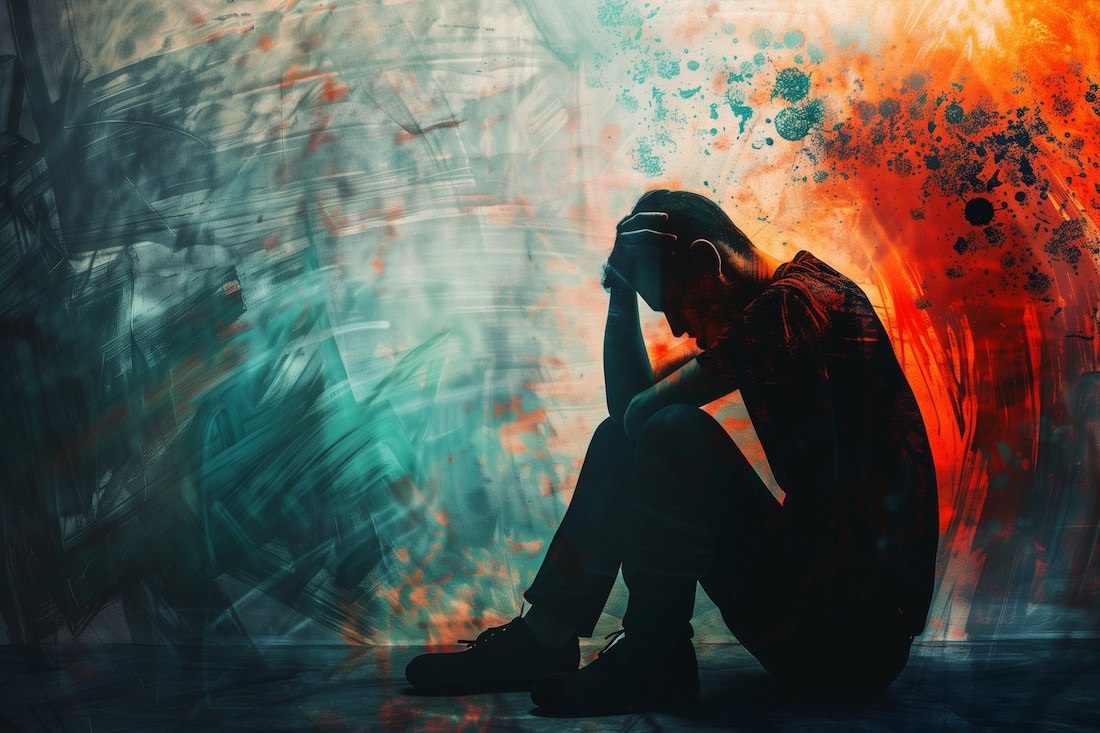Bipolar disorder, sometimes known as bipolar spectrum disorder, is a complex mental health condition characterized by extreme mood swings that range from manic highs to depressive lows. There are three main types of bipolar disorder: bipolar I, bipolar II, and cyclothymic disorder. While all three types share similarities, they differ in severity and frequency of symptoms and often require different treatment methods.
Bipolar I and bipolar II are the most common types of bipolar disorder; they also cause the most debilitating symptoms.
Let’s explore the definitions of bipolar I and II and break down the specific ways these disorders can impact a person’s mood, energy levels, and behavior.
What is Bipolar Disorder?
Bipolar disorder is a serious mental illness that causes noticeable changes in a person’s moods, emotions, and activity levels. The condition can be either episodic or chronic, depending on the individual. Past terms for bipolar disorder included “manic-depressive disorder” or “manic depression,” but the condition is now exclusively referred to as bipolar disorder.
Bipolar disorder is characterized by two distinct and extreme mood episodes: mania and depression. The severity and duration of these episodes can change depending on a person’s particular diagnosis.
During a manic episode, a person with bipolar disorder feels and acts abnormally excited, elated, irritable, or “up” and experiences notable increases in activity levels. During a depressive episode, the person feels sad, hopeless, indifferent, or “down,” and experiences abnormally low activity levels. Some people experience hypomanic episodes which are similar to manic episodes but do not cause notable impairment in daily functioning or require hospitalization.
There are three main types of bipolar disorder: Bipolar I, Bipolar II, and cyclothymic disorder. Each subtype of the condition has distinct symptoms that set it apart, but here we’re focusing specifically on Bipolar I and II.
Bipolar 1 Vs. Bipolar 2
What are the features and symptoms that separate bipolar I and II?
Bipolar I Disorder
Bipolar I disorder is characterized by manic episodes (periods of extremely elevated or irritable mood) that last for at least one week, with mood effects present nearly all day every day.
When a person with bipolar I is in a manic phase, they may display the following behaviors:
- Inflated self-confidence and belief in personal abilities; grandiose delusions
- Decreased need for sleep
- A surge in goal-directed behaviors, i.e. pursuing far-fetched business ideas, impulsively redesigning one’s home
- Increased impulsivity and agitation resulting in poor decision-making, i.e. going on huge shopping sprees, engaging in risky sexual encounters, or getting into physical altercations
- Pressured speech, i.e. talking quickly and erratically without stopping
- Racing thoughts, i.e. rapidly switching from one topic to another during conversation
- High distractibility
- Visible agitation and high energy, i.e. jumpiness or edginess
When compared to people with bipolar II disorder, people with bipolar I disorder are more likely to experience psychosis which is characterized by hallucinations, delusions, or a co-occurrence of both. Two-thirds of people with bipolar I experience psychotic symptoms at some point in their lives [1].
Depressive Episodes in Bipolar I Disorder
People with bipolar disorder I often cycle through periods of mania and depression. However, major depressive episodes are not a universal experience for BP I and thus are not required for a diagnosis.
Bipolar II Disorder
Bipolar II disorder is distinguished by the the absense of full-blown manic episodes; instead, individuals experience alternating episodes of hypomania and depression. Hypomanic episodes are less severe than manic episodes but still involve abnormally elevated or irritable mood and increased energy levels. Hypomania often feels enjoyable and productive, leading some individuals to dismiss it as a normal part of their personality or to attribute it to external factors.
Unlike those with bipolar I, all individuals with bipolar II disorder experience major depressive episodes.
Depressive Episodes in Bipolar I vs. Bipolar II
While both Bipolar I and Bipolar II involve depressive episodes, the frequency and severity of depression is different in these conditions.
In Bipolar I
In Bipolar I disorder, depressive episodes are often interspersed with manic episodes. The duration and intensity of each episode varies from person to person, but individuals with Bipolar I may spend a significant amount of time in a depressive state, struggling with feelings of sadness, lethargy, and loss of interest in activities they once enjoyed.
Critically, not all people with bipolar I disorder experience major depressive episodes.
In Bipolar II
To receive a diagnosis of bipolar II, an individual must experience at least one depressive episode, independent of hypomania, that lasts for at least two consecutive weeks, with effects present for most of the day every day.
The hypomanic episodes experienced in Bipolar II have a relatively short duration of 4 consecutive days, followed by the longer period of depression. Recognizing the subtle signs of hypomania is crucial for an accurate diagnosis of Bipolar II.
Diagnosis Challenges and Overlaps
The overlap of Bipolar I and Bipolar II symptoms with other mental health conditions can make it challenging to diagnose. Symptoms of bipolar disorder appear similar to other conditions such as major depressive disorder or attention-deficit/hyperactivity disorder (ADHD). Additionally, some individuals seek help only during a depressive episode and neglect to mention their previous manic or hypomanic episodes.
Misdiagnosis and Delayed Treatment
Misdiagnosis is not uncommon, with some individuals receiving treatment for depression without addressing their underlying bipolar disorder. This delay in accurate diagnosis can result in inappropriate medications and interventions, potentially worsening symptoms and complicating long-term management of the condition.
Bipolar Spectrum
Recognizing the existence of a bipolar spectrum has also added complexity to diagnosis. Some individuals may exhibit symptoms that fall somewhere between Bipolar I and Bipolar II, further emphasizing the need for a thorough and nuanced assessment by mental health professionals.
Treatment Approaches
Effective treatment of bipolar disorder involves a combination of pharmacotherapy (medication), psychotherapy, and lifestyle modifications. However, the specific approach may vary based on the subtype of bipolar disorder.
Bipolar I
Mood stabilizers such as lithium or anticonvulsant medications are often prescribed to manage manic episodes for individuals with Bipolar I disorder. Antidepressants may be included in the treatment plan, but they are typically used with caution due to the risk of inducing manic episodes.
Bipolar II
In Bipolar II, mood stabilizers remain a cornerstone of treatment, but antidepressants are more commonly prescribed to address the prolonged depressive episodes associated with the condition. Careful monitoring is crucial to prevent the induction of hypomanic states by antidepressant medications.
Finding Help for Bipolar Disorder
Both Bipolar I and Bipolar II disorders have a significant impact on quality of life for affected individuals. The cyclical nature of the conditions can lead to disruptions in personal relationships, employment, and overall well-being. However, with proper diagnosis and management, individuals with bipolar disorder can lead fulfilling lives.
Understanding the difference between Bipolar I and Bipolar II is crucial for accurate diagnosis and effective treatment. While both subtypes share the feature of noticeable mood swings, the intensity and duration of manic or hypomanic episodes, as well as the prominence of depressive episodes, set them apart.
Seeking mental health treatment can help you or your loved one identify the type of bipolar disorder you experience and connect you with the help you need. Clearview Treatment Programs understands the unique needs of individuals with bipolar disorder, and our facility is equipped to provide that necessary support. If you would like to learn more about our programs at Clearview, connect with one of our locations today!
Sources:
- National Institute of Mental Health. (2023). Bipolar Disorder.
- National Institute of Mental Health. (2023). Bipolar Disorder Info Center.
References:
- Chakrabarti, Subho, and Navdeep Singh. “Psychotic Symptoms in Bipolar Disorder and Their Impact on the Illness: A Systematic Review.” World Journal of Psychiatry, vol. 12, no. 9, 2022, pp. 1204–1232, https://doi.org/10.5498/wjp.v12.i9.1204.



